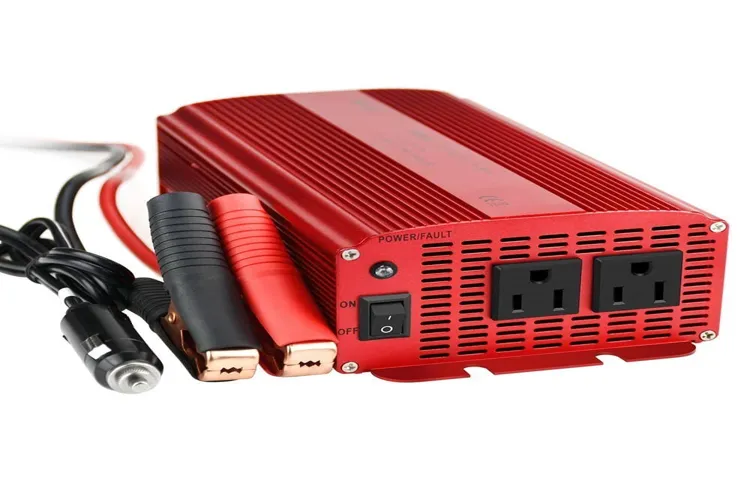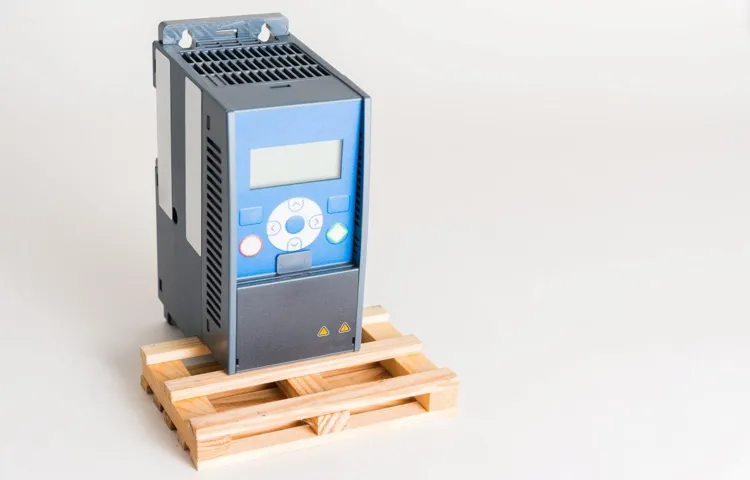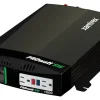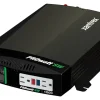Have you ever wondered how you can power your devices when you’re on the go? Whether you’re on a camping trip or traveling in an RV, having a reliable source of power is essential. That’s where power inverters come in. A power inverter is a device that converts DC (direct current) power from a battery or solar panel into AC (alternating current) power that can be used to run household appliances and electronics.
Think of a power inverter as a translator between two different languages. Just like a translator helps you communicate in a language you don’t understand, a power inverter helps your devices communicate with a power source that speaks a different language. It takes the DC power from your battery or solar panel and “translates” it into AC power that your devices can understand and use.
Power inverters come in various sizes and capacities, ranging from small portable inverters that can power a laptop or phone charger to large inverters that can power an entire RV or home. They are typically equipped with multiple AC outlets and may also have USB ports for charging smaller devices. But how exactly does a power inverter work? Well, it starts by receiving DC power from a battery or solar panel.
The inverter then uses electronic circuitry to convert this DC power into AC power. The AC power produced by the inverter is similar to the power you would get from a wall outlet in your home. This allows you to plug in and power a wide range of devices, from laptops and TVs to kitchen appliances and power tools.
One important thing to consider when using a power inverter is its wattage capacity. Each device you plan to power will require a certain amount of wattage, so it’s crucial to choose an inverter that can handle the total wattage of your devices. Keep in mind that some devices, like refrigerators or air conditioners, may require a higher wattage during startup, so make sure your inverter can handle the peak power demands as well.
In conclusion, power inverters are an essential tool for anyone who needs to power their devices when they’re away from a traditional power source. Whether you’re camping, traveling in an RV, or experiencing a power outage, a power inverter can provide you with the AC power you need to keep your devices running. Just like a translator helps you communicate in a foreign language, a power inverter helps your devices communicate with a different type of power source.
Table of Contents
What is a power inverter?
A power inverter is a device that converts DC (direct current) power into AC (alternating current) power, allowing you to use your electronic devices that require AC power when you’re on the go. It’s like having a portable electrical outlet. But how much power does a 2000w inverter actually use? Well, the power consumption of an inverter depends on a few factors.
Firstly, it depends on the efficiency of the inverter itself. A higher efficiency means that less power is wasted during the conversion process. So, a 2000w inverter may use slightly less than 2000w of power while operating.
Additionally, the power consumption also depends on the load that you connect to the inverter. If you have a device that requires 2000w of power connected to the inverter, then the inverter will use close to 2000w of power. However, if you have a device that requires only 1000w of power connected to the inverter, then the inverter will use only around 1000w of power.
It’s important to note that while the inverter may have a power rating of 2000w, it doesn’t mean it will constantly use that amount of power. The power consumed by the inverter will vary depending on the load connected to it. So, when choosing an inverter, it’s a good idea to consider the power requirements of the devices you plan to use with it to ensure that the inverter can handle the load efficiently.
Definition and purpose of a power inverter
power inverter, purpose of a power inverter A power inverter is a device that converts direct current (DC) power into alternating current (AC) power. This is important because many devices and appliances in our daily lives, such as laptops, televisions, and refrigerators, require AC power to operate. A power inverter allows us to use these devices and appliances even when we don’t have access to a traditional AC power source, such as when camping or during a power outage.
The purpose of a power inverter is to provide a convenient and portable source of AC power. By converting DC power from a battery or a solar panel into AC power, a power inverter allows us to power our electronic devices and appliances no matter where we are. This can come in handy in a variety of situations, from emergencies to outdoor activities.
For example, if you’re out camping and want to charge your phone or power a small portable fan, a power inverter can make that possible by converting the DC power from your car’s battery into usable AC power. In summary, a power inverter is a device that allows us to convert DC power into AC power, enabling us to use our electronic devices and appliances even when we don’t have access to a traditional AC power source. Its purpose is to provide a portable and convenient source of AC power, making it possible to use our devices and appliances in a variety of situations.

How does a power inverter work?
When it comes to power inverters, it’s important to understand how they work and how much power they consume. A power inverter is a device that converts DC (direct current) power from a battery into AC (alternating current) power that can be used to run household appliances and electronics. The amount of power a 2000w inverter uses will depend on the specific appliances and electronics that are being powered.
Some devices may require more power to operate, while others may require less. It’s always a good idea to check the power requirements of the appliances and electronics you plan to use with the inverter to ensure that it is capable of providing enough power. Additionally, factors such as inefficiency in the conversion process and the overall capacity of the battery can also affect the power consumption of the inverter.
So, while a 2000w inverter is capable of providing a certain amount of power, the actual power consumption may vary depending on the specific circumstances.
Explanation of the conversion process from DC to AC
power inverter, DC to AC, conversion process
Power rating and consumption
Have you ever wondered how much power a 2000-watt inverter uses? Well, let’s dive into the world of power ratings and consumption to find out! Power rating refers to the maximum amount of power that an inverter can deliver. In this case, a 2000-watt inverter is capable of producing up to 2000 watts of power. However, the actual power consumption of the inverter will vary depending on the load connected to it.
If you are using a device that requires 1000 watts of power, then the inverter will draw that much power from the battery. So, essentially, the power consumption of a 2000-watt inverter depends on the devices connected and the amount of power they require. It’s important to note that inverters themselves consume a small amount of power even when no devices are connected.
This power draw is usually negligible, but it’s always a good idea to consider it when calculating overall power consumption.
Understanding power rating in inverters
power rating in inverters, power consumption in inverters, understanding inverters
Factors affecting power consumption
When it comes to power consumption, one of the most important factors to consider is the power rating of a device. The power rating refers to the maximum amount of power that a device can consume or output. Devices with higher power ratings generally consume more electricity than those with lower ratings.
This is because devices with higher power ratings require more energy to function efficiently. For example, a high-end gaming computer with a power rating of 500 watts will consume more electricity than a basic laptop with a power rating of 50 watts. It’s important to consider the power rating when choosing devices, as it directly affects your electricity bill.
Calculating power consumption of a 2000W inverter
Have you ever wondered how much power a 2000W inverter actually uses? Well, let’s break it down for you. An inverter is a device that converts direct current (DC) power from a battery into alternating current (AC) power that can be used to run household appliances. In the case of a 2000W inverter, it has a capacity to deliver up to 2000 watts of power.
However, the actual power consumption of the inverter will depend on the load connected to it. If you have a device that requires 1000 watts of power, the inverter will draw close to 1000 watts from the battery to meet that demand. It’s important to note that inverters do have some power consumption when idle, but this is usually minimal compared to the power used when running a load.
So, to answer the question of how much power a 2000W inverter uses, it depends on the load connected to it. The inverter itself is just a means to convert and deliver the power needed for your devices.
Formula for calculating power consumption
power consumption, 2000W inverter, calculating power
Example calculation for a 2000W inverter
power consumption, 2000W inverter, calculation
Efficiency of power inverters
If you’re considering using a 2000w power inverter, you might be wondering how much power it actually uses. Well, the efficiency of power inverters can vary, but in general, you can expect a 2000w inverter to consume around 10% to 20% of its total capacity when idle or not being used. So, if your inverter is not powering any devices, it will use around 200 to 400 watts of power.
However, when you start using the inverter to power devices, the power consumption will increase depending on the load. It’s important to keep in mind that the efficiency of an inverter is not 100%, as there are always some losses in the conversion process. So, to ensure you’re getting the most out of your inverter and minimizing power wastage, it’s a good idea to choose an inverter with high efficiency ratings and only use it when necessary.
Explanation of efficiency and its impact on power consumption
power inverters, efficiency, power consumption
Conclusion
In conclusion, the question of how much power a 2000W inverter uses is like trying to figure out how much energy an adrenaline-filled squirrel consumes while doing backflips in a lightning storm. It’s an electrifying concept, but not as straightforward as it seems. You see, an inverter is like a sly magician, converting DC power from your battery into AC power that your electronic devices can frolic and dance with.
And just like a magician, it has a few tricks up its sleeve. While a 2000W inverter is capable of generating a maximum power of 2000W, it doesn’t mean it greedily consumes all of that power all the time. Think of it as a secret agent stealthily using power only when necessary, conserving energy like James Bond conserves his martinis.
The power consumption of an inverter depends on various factors such as the load connected to it and the efficiency of the inverter itself. It’s like a tango between your devices’ power requirements and the inverter’s ability to deliver that power efficiently. So, it’s not just about the inverter hogging power, but rather a delicate balance between demand and supply.
To put it simply, the power consumed by a 2000W inverter is like a well-choreographed dance routine. It flows and adjusts according to the needs of the devices connected to it, making sure they perform their electrifying moves without any power wastage. So, the next time someone asks you how much power a 2000W inverter uses, just give them a knowing smile and tell them it’s a dance of energy conservation, where the inverter effortlessly moves to the rhythm of power requirements, leaving no room for excess voltage to show off.
FAQs
How does a power inverter work?
A power inverter works by converting DC (direct current) power from a battery or solar panel into AC (alternating current) power, which is used to power electronic devices.
What are the different types of power inverters?
There are three main types of power inverters: pure sine wave inverters, modified sine wave inverters, and square wave inverters. Each type has its own advantages and disadvantages.
How do I choose the right size inverter for my needs?
To choose the right size inverter, you need to calculate the total power consumption of the electronic devices you want to power and then add a safety margin. This will give you the minimum power rating you need for your inverter.
Can a power inverter drain my car battery?
Yes, if you use a power inverter for an extended period of time without the engine running, it can drain your car battery. It is recommended to run your engine or use a deep cycle battery when using a power inverter for an extended period.
How efficient are power inverters?
Power inverters can range in efficiency from around 80% to over 90%. Higher efficiency inverters convert more of the DC power into AC power, resulting in less wasted energy and longer battery life.
Are power inverters safe to use?
Power inverters are generally safe to use, but it is important to follow proper safety precautions. Make sure to use the correct gauge wire for your inverter, avoid overloading the inverter, and keep it well-ventilated to prevent overheating.
Can a power inverter be used with solar panels?
Yes, a power inverter can be used with solar panels to convert the DC power generated by the panels into AC power that can be used to power your home or other electronic devices.
What is the difference between a modified sine wave inverter and a pure sine wave inverter? A8. A modified sine wave inverter produces a stepped waveform that approximates a sine wave, while a pure sine wave inverter produces a smooth waveform that is almost identical to the waveform of power supplied by utilities.
Can a power inverter be used during a power outage?
Yes, a power inverter can be used during a power outage to provide temporary power to essential devices. However, it is important to have a backup power source, such as a generator or a battery, to ensure continuous power.
How long can a power inverter run on a battery?
The run time of a power inverter on a battery depends on the capacity of the battery and the power consumption of the devices connected to the inverter. It is recommended to use deep cycle batteries for longer run times.



